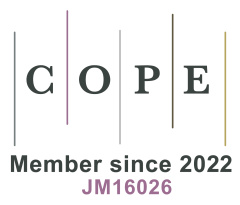LncRNA-CR848007.6 regulates the translatome of Cadmium malignant transformed 16HBE cells from a biomechanical perspective
Abstract
Background: Previous studies found that cadmium (Cd) was an environmental toxicant that not only induces toxicological effects but also disrupts cellular biomechanics, affecting cell stiffness, motility, and mechanotransduction pathways. LncRNA-CR848007.6 played an important regulatory role in cadmium toxicology. However, whether its regulatory mechanism involves the biomechanics and changes of the translatome remains to be elucidated. Objective: This study aimed to explore the function and mechanism of LncRNA-CR848007.6 in translation regulation and biomechanical properties during cadmium malignant transformed human bronchial epithelial cells (16HBE cells) through translatome sequencing techniques and bioinformatics methods. Methods: RNA interference technology was applied to silence the expression of LncRNA-CR848007.6 in cadmium malignant transformed 16HBE cells. The libraries of mRNA and RNC were constructed, and Ion Proton™ Sequencer was used for transcriptome and translatome sequencing. Mechanical properties of cells, including stiffness and traction forces, were measured using atomic force microscopy and traction force microscopy. Transcriptome and translatome differential expressions were analyzed using R software. The cell cycle and apoptosis were detected by flow cytometry to verify the functions of LncRNA-CR848007.6 regulating the translatome of cadmium malignant transformed 16HBE cells. Results: Four libraries were obtained after sequencing, including 24062 genes from the transcriptome of the siR mR group cell and NC mR group cell, the translatome of siR RNC group cell and the NC-RNC group cell. It was found that there was little change in the number of transcriptome genes between the siR RNC group cell and NC-RNC group cell, with 19 differentially expressed genes downregulated and 0 differentially expressed genes upregulated. There were 114 genes in the translatome with a ration < −2 and 65 genes in the translatome with a ratio > 2. There was no intersection between the differential TR expression genes and differential mRNA expression genes. The GO analysis results showed significant changes in the translation ratio of cell cycle and mitotic-related pathways, but no enriched KEGG pathway appeared. The cell cycle progression was regulated and cell apoptosis was signficantly inhibited (P < 0.05) after silencing lncRNA-CR848007.6 by siRNA in CdCl2 malignant transformed 16HBE cells. Transcriptome and translatome analyses revealed differential expression of genes involved in cytoskeletal organization and mechanosensitive signaling. Conclusion: LncRNA-CR848007.6 plays a critical role in modulating the biomechanical properties of cadmium-malignant transformed 16HBE cells, influencing cell stiffness and motility through translational regulation. This study provides insights into the biomechanical mechanisms underlying lncRNA-mediated cellular responses to cadmium toxicity.
References
1. Zhao J, Qin B, Nikolay R, et al. Translatomics: The Global View of Translation. International Journal of Molecular Sciences. 2019; 20(1): 212. doi: 10.3390/ijms20010212
2. Schwanhäusser B, Busse D, Li N, et al. Global quantification of mammalian gene expression control. Nature. 2011; 473(7347): 337-342. doi: 10.1038/nature10098
3. Román ÁC, Benítez DA, Díaz-Pizarro A, et al. Next generation sequencing technologies to address aberrant mRNA translation in cancer. NAR Cancer. 2024; 6(2). doi: 10.1093/narcan/zcae024
4. Wu C, Lu X, Lu S, et al. Efficient Detection of the Alternative Spliced Human Proteome Using Translatome Sequencing. Frontiers in Molecular Biosciences. 2022; 9. doi: 10.3389/fmolb.2022.895746
5. Melani RD, Gerbasi VR, Anderson LC, et al. The Blood Proteoform Atlas: A reference map of proteoforms in human hematopoietic cells. Science. 2022; 375(6579): 411-418. doi: 10.1126/science.aaz5284
6. Michael AC, Christopher JS, Lisa MB. Spatial transcriptomics in cancer research and potential clinical impact: a narrative review. J Cancer Res Clin Oncol. 2024;150(6): 296. doi: 10.1007/s00432-024-05816-0
7. Bautista CJ, Arango N, Plata C, et al. Mechanism of cadmium-induced nephrotoxicity. Toxicology. 2024; 502: 153726. doi: 10.1016/j.tox.2024.153726
8. Bhardwaj JK, Bikal P, Sachdeva SN. Cadmium as an ovarian toxicant: A review. Journal of Applied Toxicology. 2023; 44(1): 129-147. doi: 10.1002/jat.4526
9. Satarug S. Is Environmental Cadmium Exposure Causally Related to Diabetes and Obesity? Cells. 2023; 13(1): 83. doi: 10.3390/cells13010083
10. Duo Y, Gao J, Yuan T, et al. Effect of sodium‐glucose cotransporter 2 inhibitors on the rate of decline in kidney function: A systematic review and meta‐analysis. Journal of Diabetes. 2023; 15(1): 58-70. doi: 10.1111/1753-0407.13348
11. Lin K, Yi Z, Lv S, et al. Uncovering the key lncRNAs in regulating cadmium accumulation and translocation in sweet sorghum. Planta. 2024; 261(1). doi: 10.1007/s00425-024-04589-7
12. Mou Y, Sun Y, Liu G, et al. Screening of differentially expressed RNAs and identifying a ceRNA axis during cadmium-induced oxidative damage in pancreatic β cells. Scientific Reports. 2024; 14(1). doi: 10.1038/s41598-024-69937-9
13. Zhou Z, Liu H, Wang C, et al. Long non-coding RNAs as novel expression signatures modulate DNA damage and repair in cadmium toxicology. Scientific Reports. 2015; 5(1). doi: 10.1038/srep15293
14. Zhou Z, Lu Q, Huang Q, et al. eIF3 regulates migration, invasion and apoptosis in cadmium transformed 16HBE cells and is a novel biomarker of cadmium exposure in a rat model and in workers. Toxicology Research. 2016; 5(3): 761-772. doi: 10.1039/c5tx00250h
15. Lei YX, Wei L, Wang M, et al. Malignant transformation and abnormal expression of eukaryotic initiation factor during human bronchial epithelial cells induced by cadmium chloride. Biomedical and Environmental Sciences. 2008; 21(4): 332-338. doi: 10.1016/S0895-3988(08)60051-3
16. Hao R, Li F, Sun-Waterhouse D, et al. The roles of MicroRNAs in cadmium toxicity and in the protection offered by plant food-derived dietary phenolic bioactive substances against cadmium-induced toxicity. Food Chemistry. 2024; 460: 140483. doi: 10.1016/j.foodchem.2024.140483
17. Al-Hawary SIS, Saleh RO, Taher SGh, et al. Tumor-derived lncRNAs: Behind-the-scenes mediators that modulate the immune system and play a role in cancer pathogenesis. Pathology - Research and Practice. 2024; 254: 155123. doi: 10.1016/j.prp.2024.155123
18. Herman AB, Tsitsipatis D, Gorospe M. Integrated lncRNA function upon genomic and epigenomic regulation. Molecular Cell. 2022; 82(12): 2252-2266. doi: 10.1016/j.molcel.2022.05.027
19. Johnsson P, Ziegenhain C, Hartmanis L, et al. Transcriptional kinetics and molecular functions of long noncoding RNAs. Nature Genetics. 2022; 54(3): 306-317. doi: 10.1038/s41588-022-01014-1
20. Shetty A, Venkatesh T, Kabbekodu SP, et al. LncRNA–miRNA–mRNA regulatory axes in endometrial cancer: a comprehensive overview. Archives of Gynecology and Obstetrics. 2022; 306(5): 1431-1447. doi: 10.1007/s00404-022-06423-5
21. Zhou Z, Huang Z, Chen B, et al. LncRNA–ENST00000446135 is a novel biomarker of cadmium toxicity in 16HBE cells, rats, and Cd-exposed workers and regulates DNA damage and repair. Toxicology Research. 2020; 9(6): 823-834. doi: 10.1093/toxres/tfaa088
22. Park YK, Hong H, Jang BC. Transcriptional and translational regulation of COX-2 expression by cadmium in C6 glioma cells. International Journal of Molecular Medicine. 2012; 30(4): 960-966. doi: 10.3892/ijmm.2012.1052
23. Zhang X, Kuang X, Cao F, et al. Effect of cadmium on mRNA mistranslation in Saccharomyces cerevisiae. Journal of Basic Microbiology. 2020; 60(4): 372-379. doi: 10.1002/jobm.201900495
24. Zhang G, Fedyunin I, Miekley O, et al. Global and local depletion of ternary complex limits translational elongation. Nucleic Acids Research. 2010; 38(14): 4778-4787. doi: 10.1093/nar/gkq196
25. King HA, Gerber AP. Translatome profiling: Methods for genome-scale analysis of mRNA translation. Brief Funct Genomics. 2016; 15(1): 22-31. doi: 10.1093/bfgp/elu045
26. Shirokikh NE, Archer SK, Beilharz TH, et al. Translation complex profile sequencing to study the in vivo dynamics of mRNA–ribosome interactions during translation initiation, elongation and termination. Nature Protocols. 2017; 12(4): 697-731. doi: 10.1038/nprot.2016.189
27. Li H. Minimap2: pairwise alignment for nucleotide sequences. Birol I, ed. Bioinformatics. 2018; 34(18): 3094-3100. doi: 10.1093/bioinformatics/bty191
28. Zhang G, Zhang Y, Jin J. The Ultrafast and Accurate Mapping Algorithm FANSe3: Mapping a Human Whole-Genome Sequencing Dataset Within 30 Minutes. Phenomics. 2021; 1(1): 22-30. doi: 10.1007/s43657-020-00008-5
29. Wang J, Wang W, Ma F, et al. A hidden translatome in tumors—the coding lncRNAs. Science China Life Sciences. 2023; 66(12): 2755-2772. doi: 10.1007/s11427-022-2289-6
30. Wang J, Zhu S, Meng N, et al. ncRNA-Encoded Peptides or Proteins and Cancer. Molecular Therapy. 2019; 27(10): 1718-1725. doi: 10.1016/j.ymthe.2019.09.001
31. Bonilauri B, Ribeiro AL, Spangenberg L, et al. Unveiling Polysomal Long Non-Coding RNA Expression on the First Day of Adipogenesis and Osteogenesis in Human Adipose-Derived Stem Cells. International Journal of Molecular Sciences. 2024; 25(4): 2013. doi: 10.3390/ijms25042013
Copyright (c) 2025 Author(s)

This work is licensed under a Creative Commons Attribution 4.0 International License.
Copyright on all articles published in this journal is retained by the author(s), while the author(s) grant the publisher as the original publisher to publish the article.
Articles published in this journal are licensed under a Creative Commons Attribution 4.0 International, which means they can be shared, adapted and distributed provided that the original published version is cited.



 Submit a Paper
Submit a Paper
